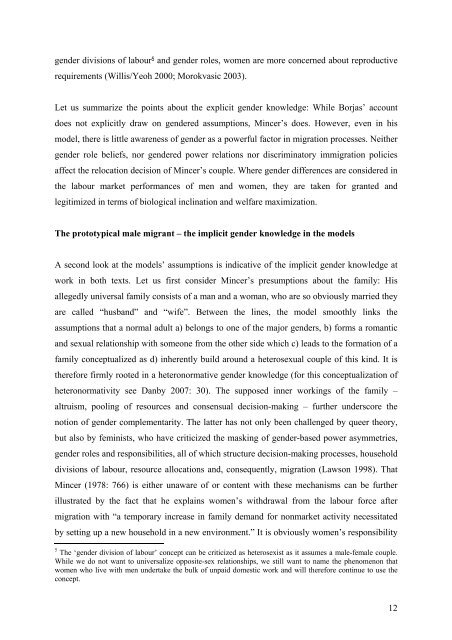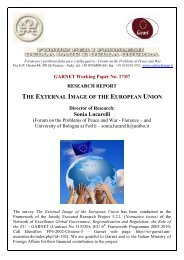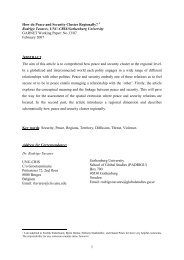1 Gender Knowledge in Economic Migration Theories and in - Garnet
1 Gender Knowledge in Economic Migration Theories and in - Garnet
1 Gender Knowledge in Economic Migration Theories and in - Garnet
You also want an ePaper? Increase the reach of your titles
YUMPU automatically turns print PDFs into web optimized ePapers that Google loves.
gender divisions of labour5 <strong>and</strong> gender roles, women are more concerned about reproductive<br />
requirements (Willis/Yeoh 2000; Morokvasic 2003).<br />
Let us summarize the po<strong>in</strong>ts about the explicit gender knowledge: While Borjas’ account<br />
does not explicitly draw on gendered assumptions, M<strong>in</strong>cer’s does. However, even <strong>in</strong> his<br />
model, there is little awareness of gender as a powerful factor <strong>in</strong> migration processes. Neither<br />
gender role beliefs, nor gendered power relations nor discrim<strong>in</strong>atory immigration policies<br />
affect the relocation decision of M<strong>in</strong>cer’s couple. Where gender differences are considered <strong>in</strong><br />
the labour market performances of men <strong>and</strong> women, they are taken for granted <strong>and</strong><br />
legitimized <strong>in</strong> terms of biological <strong>in</strong>cl<strong>in</strong>ation <strong>and</strong> welfare maximization.<br />
The prototypical male migrant – the implicit gender knowledge <strong>in</strong> the models<br />
A second look at the models’ assumptions is <strong>in</strong>dicative of the implicit gender knowledge at<br />
work <strong>in</strong> both texts. Let us first consider M<strong>in</strong>cer’s presumptions about the family: His<br />
allegedly universal family consists of a man <strong>and</strong> a woman, who are so obviously married they<br />
are called “husb<strong>and</strong>” <strong>and</strong> “wife”. Between the l<strong>in</strong>es, the model smoothly l<strong>in</strong>ks the<br />
assumptions that a normal adult a) belongs to one of the major genders, b) forms a romantic<br />
<strong>and</strong> sexual relationship with someone from the other side which c) leads to the formation of a<br />
family conceptualized as d) <strong>in</strong>herently build around a heterosexual couple of this k<strong>in</strong>d. It is<br />
therefore firmly rooted <strong>in</strong> a heteronormative gender knowledge (for this conceptualization of<br />
heteronormativity see Danby 2007: 30). The supposed <strong>in</strong>ner work<strong>in</strong>gs of the family –<br />
altruism, pool<strong>in</strong>g of resources <strong>and</strong> consensual decision-mak<strong>in</strong>g – further underscore the<br />
notion of gender complementarity. The latter has not only been challenged by queer theory,<br />
but also by fem<strong>in</strong>ists, who have criticized the mask<strong>in</strong>g of gender-based power asymmetries,<br />
gender roles <strong>and</strong> responsibilities, all of which structure decision-mak<strong>in</strong>g processes, household<br />
divisions of labour, resource allocations <strong>and</strong>, consequently, migration (Lawson 1998). That<br />
M<strong>in</strong>cer (1978: 766) is either unaware of or content with these mechanisms can be further<br />
illustrated by the fact that he expla<strong>in</strong>s women’s withdrawal from the labour force after<br />
migration with “a temporary <strong>in</strong>crease <strong>in</strong> family dem<strong>and</strong> for nonmarket activity necessitated<br />
by sett<strong>in</strong>g up a new household <strong>in</strong> a new environment.” It is obviously women’s responsibility<br />
5 The ‘gender division of labour’ concept can be criticized as heterosexist as it assumes a male-female couple.<br />
While we do not want to universalize opposite-sex relationships, we still want to name the phenomenon that<br />
women who live with men undertake the bulk of unpaid domestic work <strong>and</strong> will therefore cont<strong>in</strong>ue to use the<br />
concept.<br />
12





